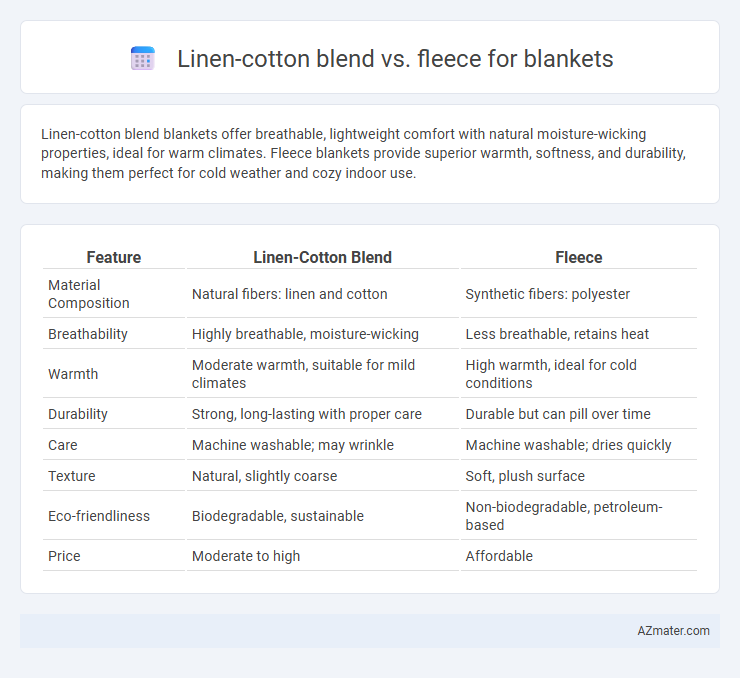Linen-cotton blend blankets offer breathable, lightweight comfort with natural moisture-wicking properties, ideal for warm climates. Fleece blankets provide superior warmth, softness, and durability, making them perfect for cold weather and cozy indoor use.
Table of Comparison
| Feature | Linen-Cotton Blend | Fleece |
|---|---|---|
| Material Composition | Natural fibers: linen and cotton | Synthetic fibers: polyester |
| Breathability | Highly breathable, moisture-wicking | Less breathable, retains heat |
| Warmth | Moderate warmth, suitable for mild climates | High warmth, ideal for cold conditions |
| Durability | Strong, long-lasting with proper care | Durable but can pill over time |
| Care | Machine washable; may wrinkle | Machine washable; dries quickly |
| Texture | Natural, slightly coarse | Soft, plush surface |
| Eco-friendliness | Biodegradable, sustainable | Non-biodegradable, petroleum-based |
| Price | Moderate to high | Affordable |
Introduction to Blanket Materials
Linen-cotton blend blankets combine the natural breathability and durability of linen with the softness and warmth of cotton, making them ideal for moderate climates. Fleece blankets, crafted from synthetic fibers like polyester, offer exceptional insulation and moisture-wicking properties, perfect for colder environments. When choosing a blanket material, factors such as temperature regulation, texture, and maintenance requirements are essential for optimal comfort and longevity.
What is a Linen-Cotton Blend?
A linen-cotton blend combines natural fibers from flax plants and cotton to create a fabric that offers the breathability and moisture-wicking properties of linen alongside the softness and durability of cotton. This blend results in a lightweight, breathable blanket ideal for warmer climates, providing comfort without excessive heat retention. Compared to fleece, which is a synthetic fabric known for its warmth and plush texture, linen-cotton blends offer enhanced airflow and natural temperature regulation.
Understanding Fleece Fabric
Fleece fabric, made from synthetic fibers like polyester, offers exceptional warmth, lightweight comfort, and moisture-wicking properties, making it ideal for blankets intended for cold conditions. Unlike linen-cotton blends that provide breathability and natural fiber benefits, fleece excels in insulation and quick-drying capabilities, enhancing cozy experiences without bulk. Its soft texture and durability resist pilling and shrinkage, ensuring long-lasting use compared to natural fiber blends.
Breathability: Linen-Cotton vs. Fleece
Linen-cotton blend blankets excel in breathability due to their natural fibers, allowing air to circulate and moisture to evaporate quickly, which helps regulate body temperature and keep you cool. In contrast, fleece blankets are made from synthetic materials that trap heat and moisture, making them less breathable and more suitable for retaining warmth in colder conditions. Choosing a linen-cotton blend enhances comfort in warm or variable climates by promoting airflow and reducing sweat buildup.
Warmth and Insulation Comparison
Linen-cotton blend blankets provide moderate warmth with excellent breathability, making them ideal for mild temperatures and preventing overheating. Fleece blankets offer superior insulation and heat retention due to their synthetic fibers and dense pile, ensuring maximum warmth in colder conditions. For optimal comfort, fleece is preferred in winter, while linen-cotton blends suit transitional seasons where moisture-wicking and lightweight warmth are essential.
Comfort and Texture Differences
Linen-cotton blend blankets offer a breathable, lightweight texture that stays cool and soft over time, making them ideal for warm climates or sensitive skin. Fleece blankets provide a plush, dense texture with exceptional warmth and a cozy feel, perfect for cold weather or snuggling. The natural fibers in linen-cotton blends create a slightly textured surface, while fleece delivers a smooth, velvety finish that traps heat effectively.
Durability and Longevity
Linen-cotton blend blankets offer superior durability due to the strong fibers of linen combined with the softness of cotton, resulting in long-lasting fabric that resists wear and tear over time. Fleece blankets, made from synthetic fibers like polyester, provide warmth and softness but tend to pill and degrade faster with frequent washing. Choosing a linen-cotton blend ensures a blanket that maintains its integrity and appearance for years, making it a more sustainable option for long-term use.
Care and Maintenance Requirements
Linen-cotton blend blankets require gentle washing in cold water and air drying to preserve fabric integrity and prevent shrinking, while fleece blankets are typically machine washable and dryable, offering greater convenience and durability. Linen-cotton blends demand careful handling to avoid wrinkles and maintain breathability, whereas fleece is more resistant to pilling and moisture, making it low maintenance. Regular lint removal and occasional fabric softener use help extend the life of fleece, in contrast to linen-cotton's need for delicate treatment to sustain its natural texture and softness.
Eco-Friendliness and Sustainability
Linen-cotton blend blankets offer superior eco-friendliness due to their use of renewable plant fibers that require less water and pesticides compared to synthetic fabrics. Fleece blankets, often made from petroleum-based polyester, have a larger environmental footprint and contribute to microplastic pollution during washing. Choosing linen-cotton blends supports sustainable agriculture and biodegradability, making them a greener option for environmentally conscious consumers.
Which Blanket Material is Right for You?
Linen-cotton blend blankets offer breathable, lightweight comfort ideal for warm climates and those who prefer natural fibers with moisture-wicking properties. Fleece blankets provide superior warmth and softness, perfect for colder seasons or users seeking plush, insulating materials. Choosing the right blanket depends on your climate, sensitivity to synthetic fabrics, and desired level of warmth and breathability.

Infographic: Linen-cotton blend vs Fleece for Blanket
 azmater.com
azmater.com